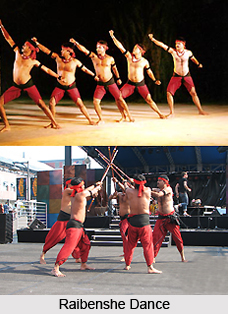 Raibenshe dance is a genre of Indian folk martial dance popular in the West Bengal state of India. Rai means royal, kingly and bansh or bansha means bamboo. This dance is exclusively performed by men who belong to the Bauris, Domes and other depressed castes of the Hindu community. Dance is a popular pastime and integral part of these communities and this dance reflects their way of life very closely.
Raibenshe dance is a genre of Indian folk martial dance popular in the West Bengal state of India. Rai means royal, kingly and bansh or bansha means bamboo. This dance is exclusively performed by men who belong to the Bauris, Domes and other depressed castes of the Hindu community. Dance is a popular pastime and integral part of these communities and this dance reflects their way of life very closely.
This folk dance form of West Bengal is remarkable for its varied expressions of military energy and depiction of martial arts. These dances serve as a reminder of the military prowess of the Bengalis. The Khasi Tribe aids them by contributing rhythm to their dance along with playing the dhol also.
In the earlier days, Raibenshe dance was performed by Bagdi community, who worked as the bodyguards of the landlords in medieval Bengal. Presently, Raibenshe dance is mostly performed in the western regions of Birbhum, Bardhaman and Murshidabad.
Performance of Raibenshe Dance
Raibeshe dance is considered as one of the manliest and energetic folk dance of Bengal. Along with the vigorous and manly movements, it involves acrobatics of a raibansh which is a long bamboo stick, from which its name originated. No songs are sung or verses recited during this martial dance. Instead, this dance is accompanied with wild yells of men, and punctuated with gestures that suggest drawing of bows from the quiver, throwing of spears, brandishing of knives and flourishing of swords, scimitar.
At times, the dancers proceed in a squat position towards the middle of the ring alternatively joining in and out while bending knees. This dance position imitates the hunters riding on the back of a horse. At other times the dancers form pairs where one of the partner stands on the shoulder of the other partner moving hands and arms. The upper partner performs the head movements and lower partner performs the foot movements. This performance requires high acrobatic skill and practice. Musical instruments like dhols (drums) and Kanshis (cymbals) accompany this dance form.
Costume of Raibenshe Dance
Raibenshe dancers usually prefer to wear comfortable attires so that they can perform the steps, specially the aerobatics one, quite flexibly. Mainly, the dancers prefer a dhoti which is the traditional dress of Bengali men. It is worn with a strip of red cloth signifying spirit and valour. The dancers also wear brass anklets known as `nupurs` on their right ankle during their performance.
Apart from traditional dancers, Raibenshe dance is also practiced by various professional dancers who do not belong to the above mentioned communities. This dance is also popularly included in various school shows. Many notable dancers even trying to revive this martial dance form by keeping its originally intact.



















